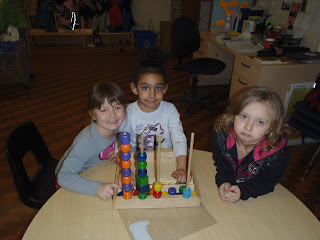Students were given instructions to blow into the straw to create bubbles from the paint, soap and water mixture. Some students stayed at this activity for a long length of time. Blowing bubbles in a cup..... an activity usually not allowed at the table!! Therefore, the students loved it. Once the students had blown enough bubbles over the top of the rim, they covered the cup with a paper to make a print.
Each student had their own straw.
Mrs. Taylor and Ms.Palmer's class received a mystery caller today! Ms. Palmer had brought in some seeds. We learned what kind of seeds they were and the best way to plant them from our Expert on the telephone. The student's were very excited to learn from a mystery voice on the phone. They listened attentively, then followed the instructions to plant the grass seeds in the 3 different areas. The students will be watching the seeds grow and measure the progress.
Building using a variety of materials from around the classroom.
Students have been busy exploring and investigating nature.
Some students may have sketched drawings, then added words into their Science Discovery notebooks. Items are continuing to be brought into the classroom from home and the schoolyard.
Students have enjoyed measuring water in different everyday containers.
These are just a few of the centres that were designed for learning today!!!

































